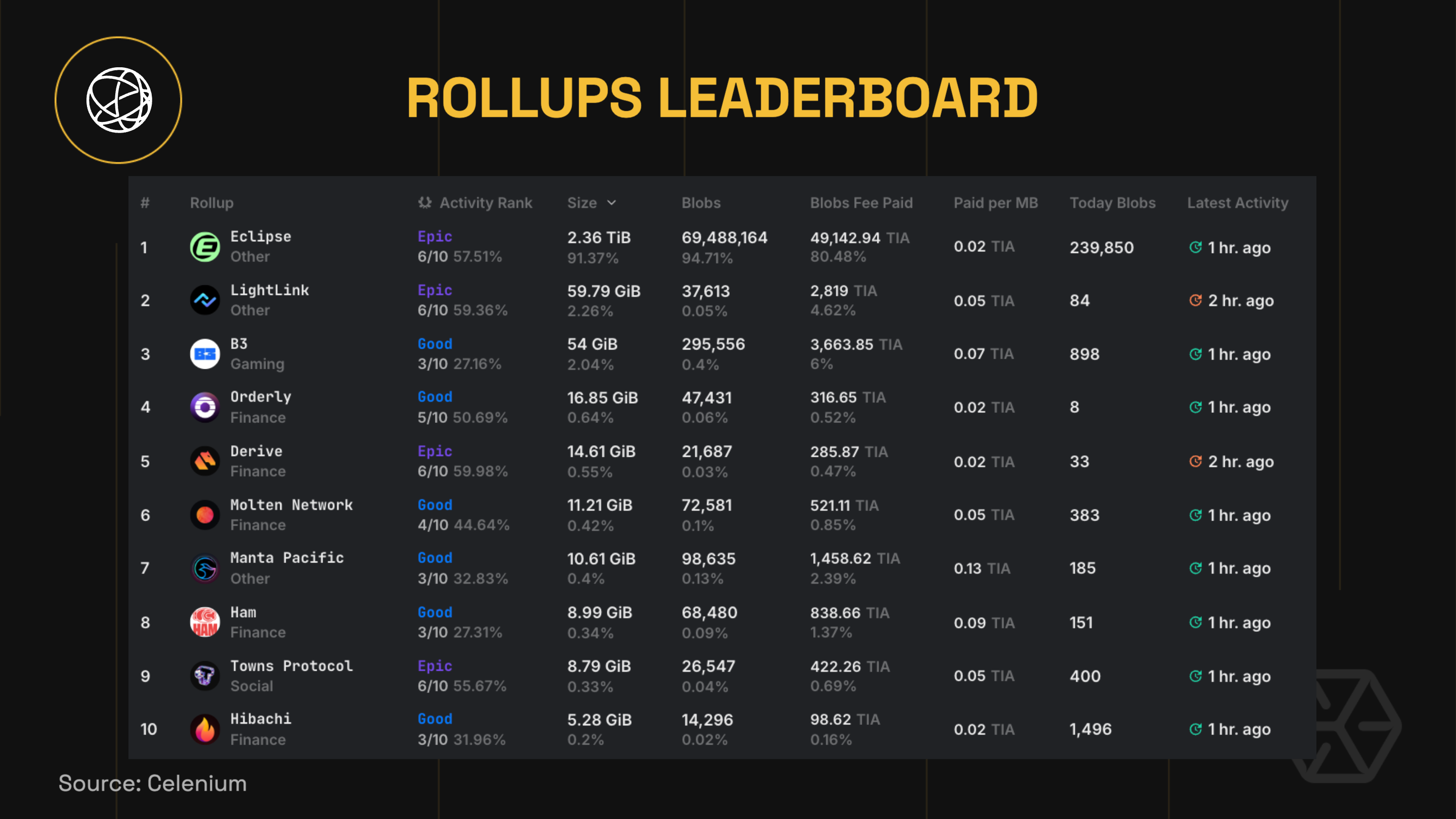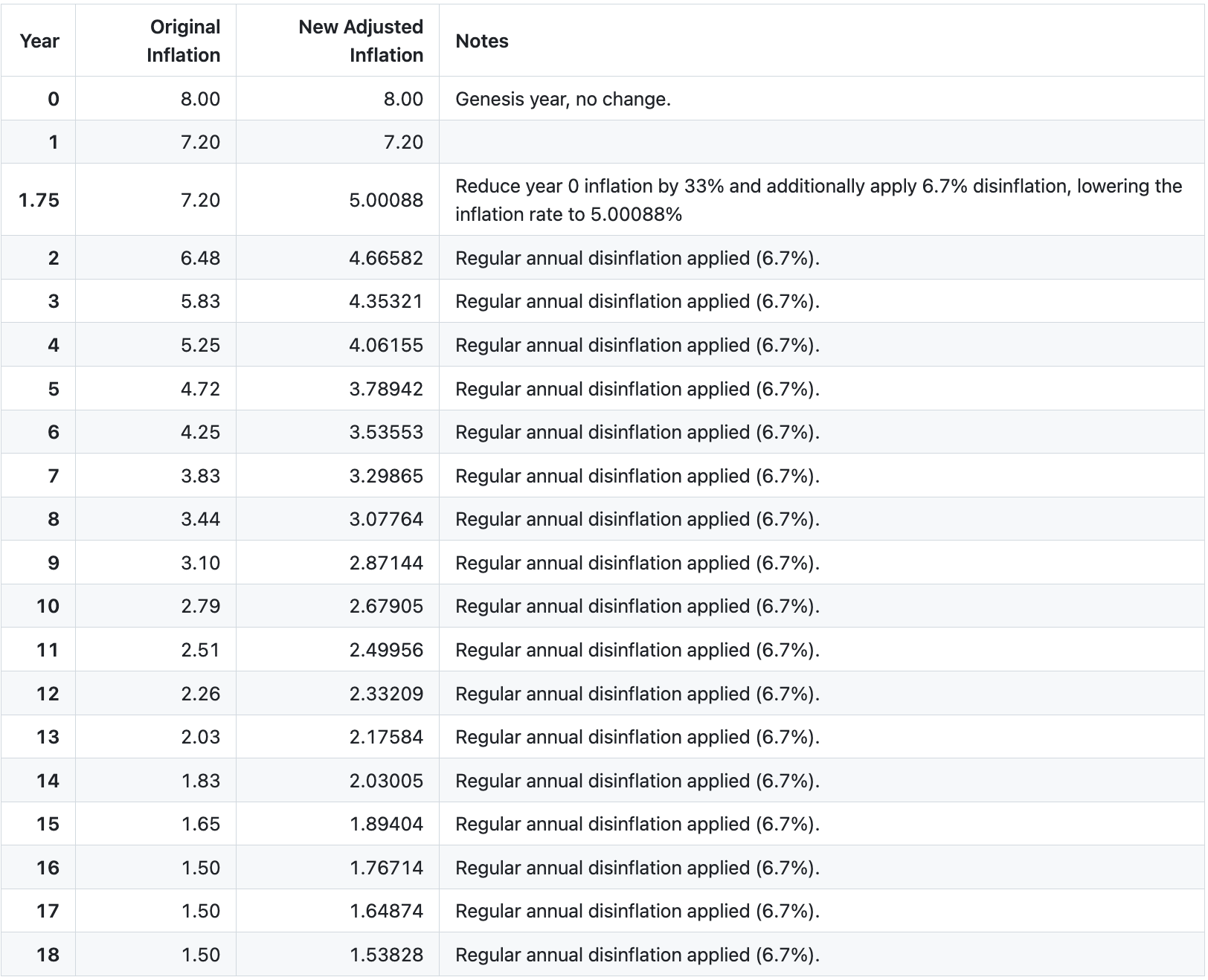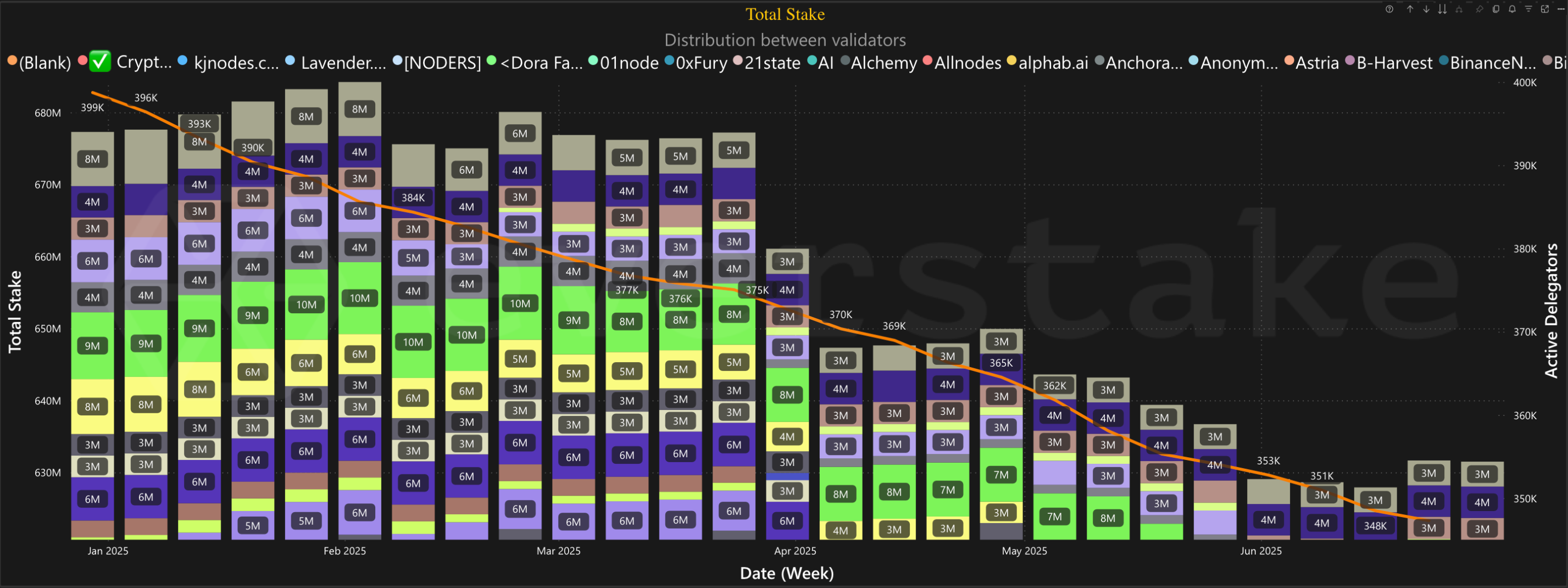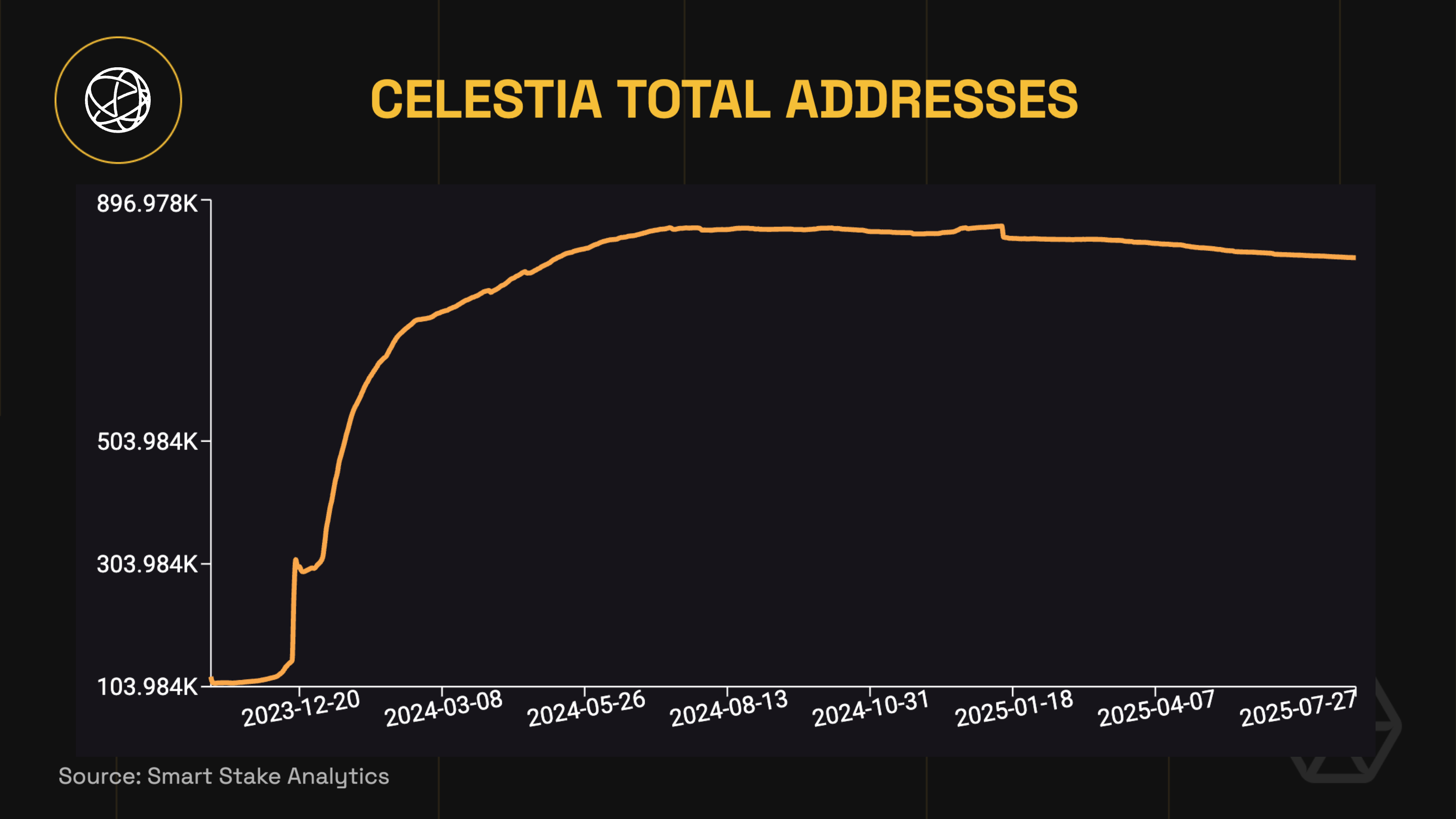The first half of 2025 marked a period of significant advancement for Celestia, particularly in the growing application ecosystem. This report provides a comprehensive overview of the network’s progress during this period, focusing on core metrics, milestones, and ecosystem expansion.
KEY INSIGHTS AND TAKEAWAYS
The first half of 2025 was a period of accelerated progress and ecosystem expansion for Celestia.
-
As of June 30, Celestia approached a cumulative total of 2.87 TB of data published on-chain, which indicates its growing role as a data availability layer of choice for modular blockchains and rollups.
-
Several new rollups and appchains joined the Celestia ecosystem, most notably through the Initia Mainnet launch (introducing 18 rollups), Citrea’s Bitcoin Appchain deployment, and Noble’s AppLayer.
-
Celestia’s total stake declined modestly from 703,62M to 621,99M TIA, while still maintaining a strong staking ratio of 55.3%.
-
Events such as Mammothon, a dedicated hackathon, and Modular Day at ETH Denver played an essential role in onboarding new developers and strengthening the modular applications ecosystem. Eleven winning projects from Mammothon are now being integrated into Celestia.
-
The release of Mamo-1, a high-throughput public testnet delivering 128MB blocks and 21.33 MB/s throughput, provided infrastructure to test future scalability enhancements and simulate real-world validator environments. It also marked a major stepping stone toward the 1GB blocks goal.
-
There have been notable advancements across all three pillars of the Celestia roadmap: Abundant, Verifiable, and Frictionless blockspace.
-
The v4 Lotus upgrade, launched on testnet, introduced significant enhancements including reduced inflation, improved staking mechanics, and native Hyperlane integration for cross-chain interoperability.
-
Mainnet block size was increased to 8MB via Governance Proposal #5.
-
Mamo-1 testnet was introduced to validate future mainnet upgrades and stress-test the network under high load in preparation for the 1 GB blocks goal.
-
PROGRESS WITH CELESTIA ROADMAP GOALS
In September 2024, Celestia unveiled its technical roadmap, structured around three primary areas.
-
Abundant Blockspace, which implies scaling to 1 GB blocks. It is expected to increase data throughput in Celestia’s rollup ecosystem dramatically.
-
The goal of supporting 1GB blocks aims to provide sufficient capacity for scaling a wide range of rollups and outlines two key paths to scaling data availability (DA) throughput: consensus optimizations, which enhance Celestia's consensus network to handle larger blocks, and Data Availability advancements, which improve the DA network to facilitate sampling and reconstruction of larger blocks while lowering resource demands for nodes.
-
-
Verifiable Blockspace, which ensures that anyone can verify the correctness of the blockspace secured by Celestia.
-
Frictionless Blockspace, which focuses on eliminating barriers for rollup developers and users. This goal is divided into three key components:
-
Lazybridging, which enhances interoperability between rollups on Celestia and the base layer.
-
Rollup developer experience optimization.
-
Blobstream, which supports ecosystem growth by enabling Celestia’s data attestations to stream into other L1s.
-
Throughout the first half of 2025, the Celestia team made noticeable progress in delivering on its long-term roadmap.
-
Launched in April, the Mamo-1 testnet provided the infrastructure to simulate real-world validator configurations, validate future mainnet upgrades, and stress-test the network under high load to prepare for the road to 1 GB blocks.
-
Governance Proposal #5 successfully passed, increasing Celestia’s mainnet block size to 8 MB and moving it closer to achieving scalable data throughput.
-
Protocol upgrades, such as Lotus, continued to improve network consensus.
-
Throughout the first half of 2025, Celestia recorded almost 3 TB in the cumulative volume of data posted on-chain.
-
Modular-focused events, such as Modular Day at ETH Denver and Mammothon, a global modular hackathon, furthered ecosystem awareness and attracted new developers into the Celestia ecosystem.
MODULAR EXPANSION
-
On April 24, the Initia Mainnet officially launched, introducing 18 new rollups to the ecosystem, set to post data to Celestia.
-
Initia is a Layer 1 blockchain based on the Cosmos SDK. It is designed to coordinate and power a network of modular Layer 2 rollups, called Minitias, which enables developers to create highly customizable applications using their preferred smart contract languages. They can post transaction data to Celestia, utilizing Celestia’s data availability layer to enhance scalability and performance, resulting in a more efficient and developer-friendly blockchain environment.
-
-
In March, Citrea introduced support for deploying Bitcoin Appchains on Citrea with Celestia serving as the data availability layer.
-
Celestia co-founder Mustafa Al-Bassam emphasized the significance of this development, stating that using Celestia as the data availability layer “is very important for Bitcoin L2s, as Bitcoin is very DA-constrained, with no plans to increase DA throughput."
-
-
On April 16, Noble introduced its Noble AppLayer, set to support an emerging ecosystem of stablecoin-native applications with Celestia underneath.
-
With an EVM-compatible rollup that uses Celestia, Noble is well-positioned to achieve its strategic objective of becoming a premier home for next-generation, permissionless stablecoin applications.
-
-
In May, four additional chains, Blackbird, Gravity, Plume, and WINR, completed their migration to Celestia.
-
As of June 2025, the Celestia ecosystem included 47 rollups.
 Source: Celenium
Source: Celenium
-
Eclipse is the leading rollup across multiple key metrics, including the number of blobs, size, and fees paid.
 Source: Celenium
Source: Celenium
MAMMOTHON
During the first half of 2025, the Celestia team was working on expanding its modular application ecosystem by hosting targeted initiatives aimed at attracting new developers to the network. A central effort during this period was Mammothon, a dedicated hackathon aiming to boost the development of modular applications leveraging Celestia.
The event attracted over 3,900 participants worldwide, creating 100+ projects and culminating in the announcement of 11 winning projects. Each of them is now being integrated into the broader Celestia ecosystem.
-
Evolute, an onchain game where players compete to capture territories.
-
zkMedia, a zero-knowledge proof image editor that verifies image transformations.
-
Weave, a web3 app that allows users to securely manage their social media accounts on Prism.
-
Xora Social, a decentralized social network built on the Chopin Framework.
-
PrivaCT, a browser extension that leverages Prism to deliver trust-minimized Certificate Transparency directly to users.
-
HAKATCHI, an onchain tamagochi.
-
XO Market, a prediction market platform.
-
We Are Lazy Dev, a reward-based system that gamifies open-source development.
-
MammothOS
GenArtz, the one-stop shop for generative art collections on Forma.
-
onMeme, an onchain meme generator and NFT marketplace.
Everstake actively supported this event by leading developer outreach efforts and assisting in the onboarding of participants.
MAMO-1 PUBLIC TESTNET
In April, Celestia launched Mamo-1, a public testnet designed to support high-throughput applications testing and simulate real-world network performance. Mamo-1 delivers 128MB blocks and achieves 21.33 MB/s of permissionless throughput. It laid the groundwork for future mainnet upgrades, including the long-term goal of supporting 1GB blocks.
-
In particular, Mamo-1 simulates realistic validator configurations.
-
It also works as a stress test for the network under intensive data loads.
-
Finally, it is set to validate scalability optimizations for upcoming mainnet upgrades.
Users can monitor testnet activity via the dedicated block explorer.
LOTUS UPGRADE
In May, Celestia unveiled the Lotus upgrade on its Arabica testnet. Its reduced inflation is set to improve the tokenomics. At the same time, the updated reward logic enhances the user experience for stakers, and the integration of Hyperlane sets a new standard for native interoperability in the modular blockchain space.
Reduced Inflation
Lotus introduced a 33% reduction in TIA issuance, lowering the annual inflation rate from approximately 7.2% to 5.0%, once applied in the respective network upgrade. Following the upgrade, inflation will continue to decline gradually by about 6.7% annually over a 17-year period. This long-term approach is expected to maintain economic sustainability while preserving validator incentives and staking rewards.
 Source: CIP-29
Source: CIP-29
No Auto-Claim of Staking Rewards
With Lotus, the automatic reward claiming when modifying delegations is disabled, allowing users to choose when to claim. This prevents unintended reward claims that could result in immediate tax obligations.
Incorporating Staking Rewards Into Vesting Account Schedules
Additionally, Lotus incorporated staking rewards into vesting account schedules, which means vesting accounts will now generate rewards that are also subject to the unlock schedule.
In many PoS blockchains, the typical configuration of lockup accounts allows users to stake locked tokens and receive immediately liquid rewards. This structure enables token holders to sell staking rewards before the lockup period of their original allocations is finished, potentially undermining the intended purpose of lockups.
The proposed change introduces a mechanism that incorporates staking rewards into the existing lockup schedule. This adjustment preserves the incentive for locked token holders to contribute to network security through staking, while keeping the staking rewards locked.
Adding Hyperlane to Celestia
The upgrade natively integrates Hyperlane, a cross-chain bridging protocol, into Celestia. This allows for secure asset transfers between Celestia and over 100 networks, including Ethereum, Arbitrum, and Base, without relying on third-party bridges. It also enables seamless interoperability between Celestia-based rollups and major L1/L2 ecosystems, marking substantial progress in modular chain connectivity.
What Comes Next
Lotus builds upon earlier milestones, such as the Ginger upgrade in 2024 that halved Celestia’s block time and introduced Doubling, a 2x increase in Celestia's data availability throughput. The rollout of Lotus brings improvements across economic, operational, and architectural areas.
The upgrade is already live on the Arabica testnet and is expected to launch on the Mainnet later this year.
STATE OF STAKING
Over the first half of 2025, Celestia has maintained its staking performance despite a modest decline in areas like total stake or active addresses.
Total Stake Growth
The total stake on Celestia slightly declined from 703,62M to 621,99M TIA. At the same time, Celestia retained one of the highest staking ratios, standing at 55.3% as of June 2025.

Delegator Dynamic
The total number of delegators decreased by 13%, declining from 401,221 to 347,292.


Redelegations
-
Throughout the first half of 2025, 15.24K Celestia delegators actively redelegated their stakes between validators, with the cumulative amount of redelegated funds reaching 6.43 million TIA.
-
The overwhelming majority (91.39%) were allocated to validators offering lower commission rates.

CUMULATIVE DATA PUBLISHED
In most networks, nodes verify data availability by downloading the entire block's transaction data. Celestia takes a different approach called data availability sampling, which allows light nodes to verify data availability without downloading the whole block.
Rollups and L2s use Celestia’s Data Availability Layer to publish and temporarily access their transaction data, significantly lowering the costs for developers and allowing them to prioritize building and optimizing their apps.
Throughout the first half of 2025, the volume of data posted to Celestia increased significantly, approaching 3TB. As of June 30, 2025, the cumulative data posted to Celestia amounted to 2.87 TB.
 Source: Celenium
Source: Celenium
ACTIVE ADDRESSES
As of June 2025, the number of active addresses on Celestia totaled approximately 806,228.
 Source: Smart Stake Analytics
Source: Smart Stake Analytics
FUTURE PROSPECTS
Celestia’s growth strategy continues to center on supporting modular application development, improving core infrastructure, and enhancing scalability.
Key upcoming initiatives include the Celestia Bootcamp, which aims to onboard a new wave of developers into the modular ecosystem, and Mammothon 2.0, a global hackathon to accelerate the creation of innovative applications powered by Celestia. Both events are expected to fuel further ecosystem activity and engagement in the year's second half.
The highly anticipated Lotus upgrade is scheduled for mainnet implementation soon. Its improvements are expected to strengthen Celestia’s economic design, user experience, and modular connectivity.
Additionally, the team continues to make progress toward the long-term goals outlined in its roadmap, including the ambitious target of supporting 1 GB blocks and making Celestia the leading DA layer for the next generation of modular blockchain applications.
